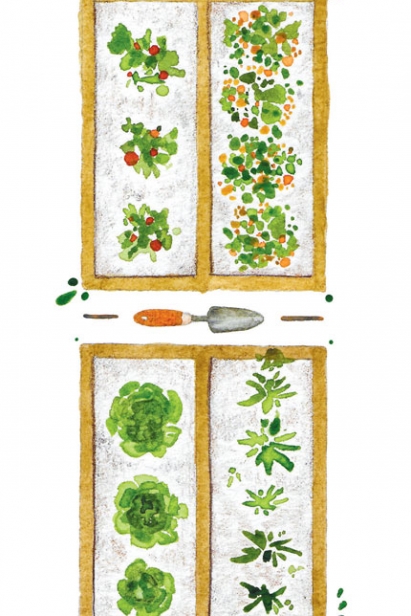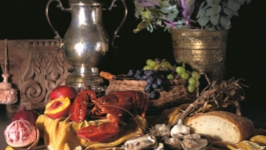Soil Creatives, Farming as a Creative Practice
Amber waves of grain. American Gothic. This Land is Your Land. Agricultural scenes are the undercurrent of many expressions by artists for good reason—the pastoral invites explorations of family, production and the familiar.
The truth of most farming these days, though, is that it’s production-oriented. Fields are frequented by machinery, farmers must outfit themselves in protective headphones to run noisy equipment and the bulk of food is processed in artificially lit warehouses by crews in hair nets. Produce arrives to the consumer as a uniform size with dull flavor and looks enhanced by waxes and glazes.
Inside the beltway of the straight rows of traditional farms, though, Central Ohio is home to creative types bucking tradition and turning to the medium of soil to exercise their artistry. For farm artists working small plots of land by hand invites a new vision of food production.
“I suppose for me gardening is a magical art form since the media we use is alive and constantly changing,” says homesteader Bernadett Szabo of Johnstown, Ohio. “I love the fact that it speaks to all my senses. It’s visual, it’s fragrant, it’s tactile and it speaks with soft rustling, humming, buzzing.”
“I often think of Over the Fence as my greatest masterpiece, a representation of my work as an artist and art educator,” shares Clintonville CSA farmer Jodi Kushins of her urban farm. “I had a vision, made a few sketches, gathered my supplies and some folks to help me turn the image in my mind into a reality in my backyard.”
“When I was a high school art teacher I often compared my students to watercolor paints,” says Jodi. “While artists can learn to control them, watercolors are a very fluid medium that can sometimes be hard to predict. Working in the garden is the same. I layout my beds and I imagine how plants will grow in relation to one another, but then the sun, wind and rain have their way, and things often turn out differently than I planned."
Creative farmers use herb spirals, keyhole beds and curved ponds to enhance the visual design of their food plots. Flowers and natural material fences add to the beauty of their working environment.
Like many artistic expressions, creative farms are sometimes controversial. “I ascribe to David Orr’s definition of green aesthetics that in order to be beautiful, something must cause no ugliness elsewhere. While some folks might think my yard looks out of place alongside my neighbors’ grass and flowerbeds, I think it’s beautiful both as a living sculpture and for its usefulness,” tells Jodi.
Farm artists often plant and sell produce as different as mass-produced hotel art is from a work of art for a small gallery or museum. Cucamelons, a tiny tart explosion of flavor prized by patrons of Clintonville’s Peace, Love and Freedom Farm, is an example of a museum-inspired fruit. Market shoppers and chefs seek out red-veined sorrel for the look of a chartreuse leaf outlined in burgundy, among other gastro-artist favorites.
Artistic farms extend their creativity into the marketplace, displaying their produce with the eye of a curator. Many record and share the elegance of their offerings on Instagram and other social media outlets. There’s even a counter-culture movement to feature ugly produce, exploring the potential beauty in what’s different from the norm and highlighting the food waste considerations of discarding non-uniform produce.
Farmers market organizers are in on the creative draw to food, too. Worthington Farmers Market, for instance, partners yearly with Igloo Letterpress to design and print a custom poster advertising market dates. This summer, Pearl Market made its mark downtown with an oversized corn sculpture installation.
Yet farm creatives face similar pressures to visual, theater, musical or dance artists. They aren’t starving artists—their product is edible after all—but the materials and time required to reach their vision often exceed financial and personal goals.
Jodi explains, “Being a farmer and being an artist both require commitment, sacrifice and drive. Thinking like an artist means looking at things differently than others. Seeing a patch of grass and imagining it as a space to grow food, for example.
Committed artists are not afraid to make sacrifices in their lives in order to make their work. Most of the people in the urban farming community are equally passionate about putting good food in people’s hands while maintaining autonomy in their own lives.”
Farmers of all sorts must be self-motivated and respond to the changing marketplace of food trends and chef whims. Add in the seasonal nature of growing outside, when a single overnight frost can ruin a crop, and the risk increases.
That’s why you’ll sometimes find soil creatives lamenting the viability of their career. Often they seek off-farm jobs, especially in the winter season when income is low or zero. The CSA model, where consumers pay ahead for shares of produce in the time farmers need the cash flow, is another way of funding the tenuous small-scale farmer vision.
“I don’t think I will become rich in a monetary sense doing what I’m trying to do,” Bernadett says, “but a lot of it is beyond that anyway. I hope that with the intelligence and persistence of the new generation of farmers we will find a way, or ways, to lessen the struggle, sustain ourselves and have a fulfilling, complete life.”







